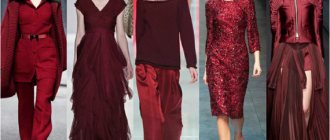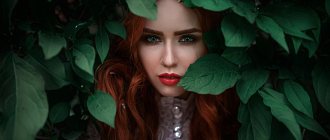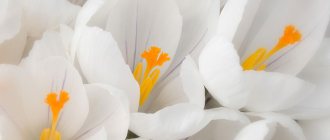Characteristics and meaning
Gray color is obtained by mixing black and white .
He is faceless, without pronounced accents, boring, and blends in with his surroundings.
You can imagine the color gray by remembering a rainy day, when the colors fade and the sky loses its bright hue. Despite its properties, gray color has many variations - from pale to dark and gloomy . The impact on the psyche depends on these shades.
Sometimes it may simply go unnoticed, but in other circumstances, gray is annoying and causes rejection. Although in general, this color is neutral and is often used in business suits or in the design of rooms where a calm atmosphere is needed.
Initially - white
What a blessing that we see the world in color! Without this, life would be boring and dull. However, a person does not immediately acquire color vision. The colored world opens up to the child in a certain sequence. First he perceives red, orange, yellow and green, and only then violet, blue and cyan. This may be because each color in the solar spectrum has a different wavelength.
White color occupies a special place. It is perceived as the color of absolute purity and, considered a symbol of something abstract, visually signifies emptiness. Please note: we perceive these black letters on a white background as an object in an impersonal, empty two-dimensional space. White color for artistic purposes can only be used when it is located between two aggressive tones or when it is used to decorate some surface that should attract attention (signs, warnings, advertising). White guide lines on a black or dark road background prevent traffic disruption, as they best attract the driver's attention. When you need to highlight the most important color, such as a fire-red fire sign, the optimal background for it is white.
What does it symbolize?
When choosing a color for clothing or interior decoration, it is worth thinking about its symbolism . Different peoples may have different shades of meaning.
Among the French it is associated with sadness, in the East - humiliation, meanness, anger, in Europe - the color of high society, some African tribes associate it with dust, for Christians gray is a renunciation from joys and worldly things.
We wear gray when we are in mourning, sadness, we want to show our isolation from the world, to set personal boundaries. This is the color of humility and sorrow.
Lilac in clothes
A very strong, noble and rich shade. This was noticed back in Turkey during the “Golden Age”. It was thanks to this perception that wearing lilac was considered a priority exclusively for representatives of royal blood. In this way, people emphasized their power and peremptory power over others.
Times have changed, clothes no longer carry hidden philosophical implications. But fashion goes in circles and clothing designers again increasingly began to turn to color psychology.
- Blue is the color of the sky and calm. The majority of flight attendants are dressed in this color. As experiments have proven, most people experience fear of flying, and looking at blue, our brain receives signals that have a calming effect on our entire nervous system.
- By wearing lilac clothes or an accessory of a similar color, you let others know that you are in a state of confidence and peace of mind. For business meetings, it is better to stick only to lavender-colored accessories; this will signal to others that this is a person who has a creative approach to business and is accustomed to achieving a goal in a short time.
- Despite the apparent coldness, lilac can encourage the interlocutor to have a pleasant and open conversation. Therefore, HR managers, when conducting interviews, often use this technique in their work. But it's not just HR managers who use the meaning of lilac and purple as a tool for their profession. Interior designers clearly know that to create a calm, relaxing and solid interior, they cannot do without the color lilac and its shades.
Properties
Gray has many shades.
If a neutral color does not evoke any emotions, then ashy can awaken sadness and depression .
Gray is used to neutralize and smooth out other, brighter colors. If you use only red, the nervous system will quickly become overexcited, but if you add gray shades, the effect will be softer.
Light gray can visually enlarge a small room, while dark shades act oppressively, reducing the perception of space.
Gray is neutral, it is a kind of border between colors, faceless, but necessary, without it it is impossible to truly feel other colors.
What are the negative character traits? You will find the list on our website.
Psychology of gray:
Special signs
If a person gives his preference to the lilac color, this means that he has the following character traits:
- Careful attitude towards objects with which both pleasant and not so pleasant memories are associated. Such people need both positive and negative emotions. But they cannot always strike the right balance. Therefore, frequent and abrupt transitions from one emotional state to another among lilac personalities are a completely normal phenomenon;
- Incredibly gullible. Deprived by nature of such qualities as opportunism and resourcefulness, such people naively believe that they live in a world where the main criterion is “do no harm.” Thanks to their gullibility, they often fall into traps “carefully” set by people more adapted to life in this difficult world;
- Prone to low self-esteem. Lavenders are not accustomed to blaming others for their failures, because they are convinced that it is primarily their fault;
- 100% altruists and perfectionists. They are convinced that there is no limit to perfection, therefore they cannot afford to perform equally similar types of work;
- They are very attentive to their appearance. Even if they are not in the best mood, they will look well-groomed;
- The material side does not interest them, for them the creative part is a priority;
- They are flighty, therefore they diligently avoid work that is monotonous and requires a lot of time to complete;
- Demanding not only of themselves, but also of others;
- Despite their openness, they are often unrestrained in a dispute;
- Such people are indispensable for family life if you are looking for a companion who will bring not only coffee to your bed, but also happiness. Their wild imagination knows no bounds. But be prepared for the fact that your lilac companion will turn out to be useless as a provider for the family.
Of course, all of the above qualities cannot be applied to all unconditional lovers of the lilac color and its shades. Psychology is a subtle science, but as progress shows, it is very effective in influencing a person when used skillfully. Advertising, design, food and clothing industries - and this is not a complete list, where they are seriously interested in how this or that color can influence the human subconscious.
What is it used for in advertising?
In advertising, gray is often used as a background. It is used to display information technology; it is associated with scientific progress .
Emphasizes the elitism of the product. This is especially true for silver shades. It evokes a feeling of reliability and speaks volumes about the quality of the product being offered.
Design studios often use gray interiors as advertising. This is the color of luxury real estate, the city, and stability .
Physiological and psychological effects on health
Gray color does not evoke stormy and bright emotions.
However, it can depress, especially when in excess.
If a person is initially in a sad, depressive mood, then the presence of gray will further aggravate the condition.
It symbolizes maturity, a businesslike attitude , and therefore is able to relieve tension in offices. This is a strict color, it is used in government agencies.
Light gray calms and induces contacts . It has a beneficial effect on the activity of the nervous system, especially in people of choleric temperament.
Dark gray has a more severe effect, depresses, slows down . Excess gray in children's rooms is not recommended.
If a person is prone to phobias and lacks self-confidence, then the gray color also has an adverse effect on him.
The main emotions it evokes are sadness, moderation, calm , and it slows down brain activity.
About what the color gray means in this video:
Psychology and lilac color
Lilac, like violet, is obtained by combining blue and red. In the past, it was extremely rare because there were difficulties in making it. And the paint was expensive. This spectrum is classified as a cold range. But it looks softer than, for example, blue and blue.
The meaning of lilac color in psychology:
- mystery;
- imagination;
- creative thinking;
- depth;
- sensitivity;
- romantic mood;
- vanity;
- distrust, wariness.
The color got its name from the well-known flower - lilac. Its “brother,” purple, is deeper. They have the same properties and characteristics. But in the first case they appear in a milder form.
What else does the color lilac mean in psychology? As stated above, it is obtained by mixing red and blue, symbolizing the masculine and feminine principles. Therefore, the shade is suitable for both sexes.
Lilac symbolizes not only qualities. It has other meanings:
- A borderline state that occurs during meditation.
- Knowledge, the search for which encourages reflection, reasoning, and intellectual development.
- For some peoples, this shade of purple can mean mourning.
- If lilac is often present in your dreams, you can talk about serious changes that will occur in the near future.
- Those who love this color scheme will never flaunt what is going on inside.
Under natural conditions, lilac is a consequence of the content of anthocyanins in plants. Most of them are found in lilacs, violets, lavender and fuchsia.
Florists consider this color spectrum to personify affection, fidelity, and the desire to reconcile. In their opinion, the more shade in a bouquet of flowers, the stronger the feelings of the giver.
In addition to the properties described above, the lilac color speaks of luxury, aristocracy and wealth. That is why its use is appropriate in bouquets for both a loved one and colleagues, a boss or just an acquaintance.
What can you say about a person who loves gray?
Lovers of gray look faceless in appearance.
It is often preferred by older, depressed, lonely people who want to be invisible and hide from others.
Such a person strives for peace and does not like external interference and contacts with other people.
There is no appetite for risk , a lover of gray tends to think for a long time, look for logic, and come up with a more acceptable and accurate solution to the problem.
Such people are good analysts , so they can often be found among accountants, economists, and teachers. There is ambition and modesty, avoidance of public speaking and attracting attention to oneself.
The character is calm, the personality rarely experiences vivid emotions and is even afraid of them. There are high moral principles and demands on other people.
At the same time, life remains quite gray, there is not enough energy , emotional charge.
Lilac in the interior
- This universal color goes harmoniously with any shade from the rainbow palette. Warm, sparkling, noble, capable of giving the interior both a feeling of business and complete relaxation and carefree. It is appropriate everywhere, from the hallway to the design of guest rooms.
- You can advantageously emphasize and visually expand small living spaces using light lilac color. But this does not mean that all the walls should turn lavender in an instant!
- Lilac is the king of accents. If you want to highlight a certain wall in the room or a detail in the interior, then go for it.
- Remember that overload with this shade can have the opposite effect on the psyche. An interior that oversaturates this basic shade looks gloomy and depressing. Therefore, create wisely.
- It is well suited for the kitchen, where it is nice to chat over a cup of aromatic tea. Teenage children may also be interested in this shade. Bedrooms of this shade in combination with white will never seem boring.
When choosing lavender, don't be afraid to experiment. If you chose it, it’s not without reason. Thus, your subconscious makes you understand that creativity is not an “empty phrase” for you and you just have to try and you will definitely succeed!
What does color aversion mean?
Those who do not like the color gray strive to diversify their lives as fully .
They prefer bright colors and adventure.
In communication they want to either win or lose, but they do not like a neutral and uncertain position .
The character may exhibit impulsiveness and frivolity . Those who deny this color are afraid of being passed over, defeated; success, contact with other people, and achievements are important to them.
They do not like “gray” and faceless people, they avoid them and do not understand them, considering them secretive and uninteresting.
Lavender color
- Lilac color means lightness, airiness, openness and is characteristic of people who have a creative streak. The pursuit of excellence is their main goal in life. They are not like those around them and always have their head in the clouds. Such people are endowed with a flexible and creative mind, improvisation is their strong point.
- As people knowledgeable in the art of psychology assure, it is easy to recognize a lilac person in a crowd; they emanate an inner glow that we instinctively attract to ourselves. After communicating with them, your soul becomes comfortable and light.
- But like any coin, there are two sides. Despite all their radiance and openness, lavender people are prone to deep depression, which can drag on for a long period of time. It is very difficult for lilacs to get out of this state on their own without outside help.
- Such people feel most comfortable in professions such as actor, critic, artist or writer. Routine office work is not for them. They are generators of ideas.
Who can I recommend using?
Gray color combines well with many other colors.
In clothes
It goes especially well with white, black, purple , diluting harsh shades.
It is suitable for a business suit. Nevertheless, it is worth diversifying it by introducing brighter elements and accessories - a tie, a bracelet, a small brooch.
Don't dress entirely in grey . A blouse, shirt, sweater should be of a different, more positive shade. Color is often used in uniforms to emphasize business orientation, responsibility, and reliability.
Gray is suitable for choleric people, if you need to smooth out your explosive temperament a little.
It is not recommended for melancholic people , despite their desire to use this color in clothes.
In them, it further depresses the nervous system. For sanguine and phlegmatic people it has a neutral effect.
What are the positive character traits? Find out about this from our article.
How to choose the shade of gray for yourself? Find out from the video:
In the interior
In interior design, gray is an indispensable element . Kitchen surfaces look good with it. The steel-colored refrigerator looks stylish and rich.
In the living room or bedroom you can hang curtains in a rich gray shade. They are combined with white and black furniture.
If you need to make the room visually more spacious, then take a light gray shade; it has a softer effect than white, does not dazzle and evokes a feeling of stability.
In rooms where rigor and impact on people are required, darker, deeper shades of gray are used. However, it should be remembered that it affects not only visitors, but also the employees themselves.
Suitable for people with intellectual work , with the caveat that the interior cannot be composed only of this color, otherwise fatigue and depression of the nervous system will occur over time.
Remember that you should not allow an excess of this color in the interior and be sure to dilute it with more joyful shades - green, yellow, red.
Gray color in the interior:
The influence of color on a person: more important than you think
From early childhood, a person is surrounded by a world in which there are many colors and their shades. And, of course, he gives preference to the most beautiful color for him, which subsequently becomes his “favorite”. So, some people may like yellow and not like black at all, while others may do the opposite. Some people like several colors at once. In this article we will try to explain the meanings of colors and their significance in human life , which in the future can help you get to know yourself in more detail and approach the choice of colors for a specific purpose better.
As you know, the influence of a certain color on the psyche of a person was noticed in ancient times by various sorcerers, shamans, etc. And even now we can say that some colors can evoke completely different emotions , for example, happiness, joy, melancholy, sadness, they can calm and, conversely, anger or irritate.
First, let's figure out what “color” is and what science studies it.
Color is, first of all, a physical phenomenon. In scientific terms, this is a characteristic of electromagnetic radiation of a special optical range - spectrum. Color perception arises based on the sensations of the visual apparatus.
In simple terms, color is a visual sensation that a person receives when light rays of different wavelengths enter the eye. Color perception is a very subjective characteristic. It turns out that each person sees colors differently.
The science that studies colors and their properties is called color science. And a method of alternative medicine, with the help of which a person is exposed to variously colored light for the purpose of healing him - color therapy . But because this method does not rely on the scientific method, and research does not support its effectiveness, it is pseudoscientific.
Color affects the human psyche, and at the same time has a pronounced character. For example, it is generally accepted that the color green is calming, so they try to paint walls in schools with this color, while red, on the contrary, excites the psyche and literally “catches” attention. Therefore, signs or prohibitory signs are depicted using the color red.
Sometimes color evokes certain reactions that can help in making a decision . It also affects appetite, behavior, blood pressure, and, in general, the human condition. For example, when the bright sun is shining, a person becomes much lighter and more cheerful, but when it is cloudy and gray, the condition worsens and the mood drops. Modern sellers and advertising writers take such factors into account and try to select specific colors that people will “listen to.” In addition, it is important to choose the colors in your home so that the household members are happy, so that certain colors do not contribute to irritability, but, on the contrary, calm everyone down. And most importantly, we must choose the right colors in our wardrobe, since we perceive colors not only through our eyes, but also through our skin.
Let's look at the 9 primary colors and describe their effect on humans.
Red color
This color literally makes a person become more active . It causes excitement in the psyche, and with its help the muscles tense and movements become more intense. Any place where this color is present, we can observe greater efficiency. But you should know that the body gradually gets used to this color, as a result of which color fatigue occurs and the result may not be the best.
Also, red is one of the most aggressive colors, which can lead to irritation and anger , so you should not stay in a room with this color for a long time. But if you cannot understand what to do in a given situation, it will give you strength and a charge of vigor. And if you still “get up on the wrong foot” in the morning, then this color, which contains cheerful notes, will be the sure cure for this problem.
Clothing of this color on a person’s body shows strong character, desire for a specific goal and perseverance, but it can also hide the insecurities and complexes of shy people. Therefore, to overcome any short-term difficulty, you should use this color.
At home, it can visually reduce space and have a good effect on digestion and stimulate appetite, so a piece with red color can be placed in the kitchen.
Orange color
This color is much softer and more delicate than the previous one. We can say that it liberates people, makes their feelings warmer . With the presence of this color, a person’s life is filled with fun and good mood. Orange itself is a business color and can promise success in career growth. There is optimism and radiance in him. It has a beneficial effect on people’s performance and their unity.
More on the blog: How to increase your level of life satisfaction and happiness
Also, this color has a good effect on brain function , so if a person is interested in creativity, this color will have a beneficial effect on both him and his activities.
The color orange has a special energy that attracts people and wins over absolutely anyone . When used in clothing or at home, a person’s positive aspects are revealed. He becomes more cheerful, bolder, and he develops leadership qualities. In addition, it relieves stress and helps get rid of depression.
Orange color enhances concentration , helps during important negotiations and even the formation of friendships. It is safe, there are no contraindications for this color, so you can safely use it in life.
At home, you can also add orange shades to your child’s room, this will help him fight loneliness and develop positive qualities, as well as in the kitchen, since this color (like red) promotes appetite.
Yellow
The color yellow evokes feelings of happiness, satisfaction and harmony . Warmth emanates from it, like from the sun. People who wear clothes with this color are most often cheerful, cheerful and leading by nature. Once you add a little yellow color to your home, a person’s mood will begin to improve from time to time. But it is worth noting that too much yellow color hurts the eye, which can lead to headaches.
It’s not for nothing that yellow is called the intellectual color . It is safe to say that it increases creativity, so a small amount of it can be used in an office or room where a person does work. For small children, this color can be harmful in large doses. They react to it most often negatively and begin to cry. And you should also not use yellow for insomnia.
Green color
This color evokes associations with nature and makes us calm and peaceful. We immediately remember a forest or park, birds singing, rustling grass underfoot with droplets of race, and fresh warm air. The soul immediately becomes calm, harmony appears, and the person becomes softer. If the color green is present on a person, then we can say that he has a quiet, calm, balanced character, knows his worth and is calm about the world around him.
This color improves vision and appetite, has a good effect on concentration and brain function, and allows you to get rid of negative emotions . It also influences the preservation of the final result and allows you to fully devote yourself to the task. It has a good effect on the cardiovascular and nervous system.
Green color makes a person most efficient. But it is worth remembering that with a large amount of green, apathy and melancholy appear. The color green may be present in the nursery, but only if the child is not phlegmatic. If this is so, the color will have a positive effect, arouse interest in learning and understanding the world, and make you self-confident.
Blue
This color calms the senses and slightly reduces activity. It is passive, so it can cause some kind of slowdown. Light blue is a combination of blue and white. Therefore, one part of it causes coolness, helps to calm down, and the second includes imagination and attentiveness.
Most often this color can be found in a school classroom or office. It influences creativity as well as the expression of one's thoughts. It has a relaxing effect on children, so the presence of this color in small doses will not be superfluous. And at home, blue color will be useful in the bedroom, as it induces drowsiness and relieves tension. However, you should not use it too often, otherwise you risk constantly needing sleep.
Blue color
Blue is a cool color. It often causes depression, leads to a significant decrease in activity and is commonly used in anti-advertising.
With its help, a person surrenders to dreams and reflections, because it is the color of the sky and sea . It creates coolness, and on a hot day the presence of this color in the room will have a positive effect on you, while it can visually expand the room. But in this case you need to be careful, since too much influence of this color can make you feel depressed.
More on the blog: 11 good reasons why I stopped reading popular fairy tales to my daughter
For hyperactive people, blue can serve as a sedative; it will help them control themselves and teach them to manage their emotions, but for melancholic people, on the contrary, it is harmful.
It can also instill self-confidence. Blue is responsible for logic and analysis of actions; with its help, a person becomes more disciplined. It also has beneficial properties on the child: it forces them to pay attention and concentrate.
Purple
This color evokes associations of luxury and looks quite mysterious . It is responsible for intuition and knowledge, helps to get rid of melancholy, but only if it is in moderation. In large quantities it causes depression and fatigue. People who wear purple clothes most often have a kind character and a timid, shy heart.
Purple color should not be chosen for decorating living rooms, as it causes a decrease in both physical and mental activity. But it will help get rid of headaches. This color is the color of the aristocracy, because before not everyone could buy it, and maybe that’s why it now evokes a sense of self-esteem.
White color
White is the color of self-confident people , as well as the color of innocence and purity. People who choose this color are most often kind by nature, but on the outside they show coldness. They do not give in to emotions and try to look at things with “sober” eyes.
If you want people to listen to you and trust you, so that it is easy for you to start any business, then your choice is white . It has limitless power, pushes you to action and at the same time gives you a feeling of freshness. Also, white color always helps to be in good shape; with its help, a person’s strength and will increase. But if there is too much white, it causes associations with the hospital and has a bad effect on work activity, and not enough of this color makes us irritable. Therefore it should be in moderation.
Black color
Black color is associated with something mysterious and scary , but at the same time, almost every person has it in their wardrobe, because it is also the color of a business person. It suits every shade and gives a certain severity. If a person has the most black items in his wardrobe, then we can say about him that he is a gloomy person who avoids society, or quite the opposite - he wants to stand out from the crowd.
This color also causes a decrease in mood, as it gives a feeling of depression. It absorbs light and causes melancholy, and in some cases causes uncertainty. But besides this, it helps to get to the truth, find what is hidden, makes you go to protest and be heard.
Thus, we observe that the influence of color on the psyche and life of a person is enormous, and by choosing the right color, you can achieve great success and radically change your life.
Survey conducted
To delve further into this topic, we surveyed 60 ordinary students , asking each one a specific question: what is your favorite color?
And this is the result we came to: fourteen students preferred blue, ten out of sixty preferred green, eight chose black, four each chose red and blue, three chose purple, two chose white and one person chose yellow.
The rest were unable to give a clear answer, but named two or more than three colors at the same time (and many named not specific colors, but their shades).
Thus, we can conclude that the majority of modern students with developed logical judgment are organized and systematized people, and at the same time calm and energetic. The smaller part of the respondents was divided into half: in one of them - bright, impulsive people, and in the other - calmer, attentive and less active.
In conclusion, we can say that the above information is useful, since color plays a huge role in our lives. And the person who reads this article will be able to correctly set his color preferences in order to achieve good results and get rid of unnecessary emotions.
source
Read our classified materials











